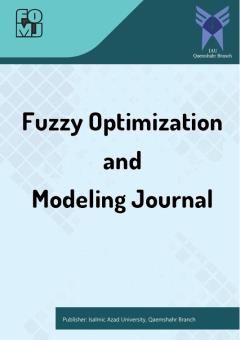A Neutrosophic Approach to the Diet Problem: Enhancing Accuracy and Flexibility in Dietary Planning
Subject Areas : Fuzzy Optimization and Modeling JournalSamira Valipour 1 * , Amirhossein Nafei 2
1 - Farvardin Institute of Higher Education, Ghaemshahr, Iran
2 - Department of Industrial Engineering and Management, National Taipei University of Technology, Taipei, Taiwan
Keywords: Diet Problem, Food Mixture, Linear Programming, Uncertainty, Neutrosophic Triplets,
Abstract :
The diet problem, as a critical challenge in the health science and the food industry, involves optimizing the combination of foods to meet nutritional requirements at minimal cost. This research presents a novel and flexible linear programming model for the diet problem, integrating neutrosophic triplets to manage the inherent uncertainties and indeterminacies in nutritional data. Neutrosophic logic extends fuzzy logic by introducing an indeterminacy component, allowing for a more nuanced representation of the variability in the food nutritional contents and costs. In our study, we examine eight types of food and four essential nutrients, representing each food’s cost and nutritional content as neutrosophic triplets. These triplets encapsulate the degrees of truth, indeterminacy, and falsity inherent in the data. By converting the neutrosophic triplets into crisp values using a specific score function, we enable the application of traditional linear programming techniques. Our model aims to minimize the cost while ensuring that the diet meets all specified nutritional constraints. The practical implications of the neutrosophic model are demonstrated through a comprehensive case study, highlighting its effectiveness in diet planning and its applications within the food industry. The results underscore the model’s ability to handle data uncertainties robustly, providing a reliable and adaptable solution to the diet problem. This approach not only enhances the precision of dietary planning but also supports improved decision-making processes within the food industry, ultimately contributing to better health outcomes and more efficient resource utilization.
1. Azimi, S.M., Chun, H., Zhihong, C. & Nafei, A. (2021). A new approach for solving interval neutrosophic integer programming problems. Fuzzy Optimization and Modeling Journal, 2(2), 1-11.
2. Babaie-Kafaki, S., Ghanbari, R. & Mahdavi-Amiri, N. An efficient and practically robust hybrid metaheuristic algorithm for solving fuzzy bus terminal location problems, Asia–Pacific Journal of Operational Research, 29(2) (2012) 1-25.
3. Eiselt, H.A. & Sandblom C.L. Linear Programming and its Applications, Springer, Newyork (2007).
4. Geissler, C. & Powers, H. Human Nutrition, Oxford University Press, Oxford (2017).
5. Izonin, I., Ribino, P., Ebrahimnejad, A. & Quinde, M (2023). Smart technologies and its application for medical/healthcare services. Journal of Reliable Intelligent Environments, 9, 1–3.
6. Li, J.T.. Liao, B., Lan, C.Y., Qiu, J.W. & Shu, W.S. (2007). Zinc, nickel and cadmium in carambolas marketed in Guangzhou and Hong Kong, China: Implication for human health. Science of The Total Environment, 388, 405-412.
7. Nafei, A., Javadpour, A., Nasseri, H., & Yuan, W. (2021). Optimized score function and its application in group multiattribute decision making based on fuzzy neutrosophic sets. International Journal of Intelligent Systems, 36(12), 7522-7543.
8. Smarandache, F. A Unifying Field in Logics: Neutrosophic Logic, Neutrosophy, Neutrosophic Set, Neutrosophic Probability, 4th Edition, Infinite Study (2005).
9. Sun, C.H. Nutrition and Food Hygiene; Peoples Medical Publishing Press, Beijing (2012).
10. Wang, H., Smarandache, F., Sunderraman, R. & Zhang, Y.Q. Interval Neutrosophic Sets and Logic: Theory and Applications in Computing, Computing Research Repository (2005).

